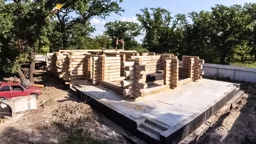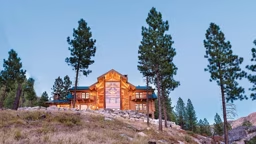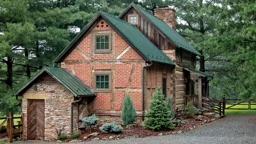
You’ve wanted a log home as long as you can remember, and you are finally going to take the leap! There’s only one problem: Your dream location is in Idaho and you live in Indiana. How can you make this work from hundreds of miles away? Who do you hire? Where do you start?
1. Choose the Right Team
Whether you’re building across the country or across the street, finding the right log provider and a builder/contractor you can trust are important. But if you won’t be onsite throughout much of the construction process, these decisions become even more crucial. Those who take the time to educate themselves usually have the best experiences, and there are a variety of ways to acquaint yourself with log home manufacturers and builders.
A simple Google search can provide you with potential designers, builders and suppliers — and that’s a good place to start; but technology alone won’t give you the full picture. There’s no substitute for shaking a builder’s hand or examining his work up close and in person.
Log home shows and seminars, open houses and log raisings take place across the United States and Canada and allow you to personally “examine the merchandise” before you commit. But one question remains: Should you choose someone who is close to where you currently live or local to your log home job site?
“A long-distance client needs a trusted set of eyes onsite from Day One through completion, and that person is usually the local licensed contractor who’s vested in the community and has a track record of performance,” advises Chris Wood, whose Tennessee-based company, Hearthstone Homes, has delivered and erected log homes in 49 of the 50 states. “Using a local log provider’s set crew is great, if available, but certainly not mandatory."
Exeter, California, log home builder Herb Meeker agrees. “In most cases we find that customers are looking to work with someone experienced with the challenges in the area in which they are building,” he says. “They’re not as concerned with where the logs come from as they are with the construction crew, especially if their site is in a remote location or on difficult terrain.”
That doesn’t downgrade the importance of choosing a high-quality log home provider; however, this decision should be made based upon which company will provide you with the type of log home you are looking for.
When it comes to selecting your manufacturer, the log species, diameter and profile you want are bigger considerations than where that company is located. And the same goes for hiring designers or architects: Going local isn’t important — talent and professionalism are.
2. Communication is Key
A builder who communicates well is essential for long-distance construction. Thanks, again, to the internet, maintaining a high level of contact has become exponentially easier and has revolutionized the design and construction process. Email, texting, video chat, and even YouTube and Vimeo make it possible for your builder to provide you with real-time progress reports and leave little room for misunderstanding when it comes to making critical onsite decisions. It also helps speed construction along.
“Years ago, before the internet, I designed and built a log home for a customer who lived in Ireland but worked on offshore oil rigs near Thailand,” Herb relates. “The only time we could have phone conversations was in the middle of the night for me when he was awake or not working. We wrote letters and mailed photos but it took a long time to communicate in this manner. Now we email photos to clients weekly to keep them abreast of the progress as stages are being completed.”
Most importantly, don’t be shy. Go through your plans with your team in detail and be specific. For instance, if you care a lot about door hardware, know exactly what you want and convey that to your builder or contractor through photographs or manufacturer’s part numbers. Using every tool at your disposal will help you visualize what’s going on at the job site when you can’t be there.
3. Schedule Periodic Visits
Digital communication is all well and good, but sometimes there’s nothing that can replace seeing things with your own eyes. The distance to your job site likely will dictate how frequently you can travel there, so schedule visits at key points in the construction process.
Work with your builder to determine the milestones along the project’s critical path that warrant your personal attention. It could be anything from log delivery day to selecting finishing materials, and it may vary from builder to builder. “When it comes to cabinets, plumbing fixtures and lighting, sometimes choices are made from the internet,” Herb says.
“Our preference is to bring our customers to local showrooms for their selection of tile, granite, flooring, appliances and certain fixtures so they can see and touch them.”
4. Cost Control
If you’re considering a long-distance log home build, you may wonder if it’s more expensive. Everything is rooted in the team you choose. If you select the right people, the costs shouldn’t be significantly greater. That said, local labor rates can vary widely, and if your manufacturer has to ship the log package a long distance, it may cause a bump in costs. Log home providers do what they can to help you in the cost-control department.
“We send our crews (usually four men) to erect the heavy timbers, using their own cranes or lifts, and we manage them on a fixed-cost basis,” says Chris Wood. “This fixed-fee approach incentivizes to the crews to work longer days and through inclement weather to minimize expenses, like hotel accommodations. And we include a money-back guaranty on the installation work, which provides peace of mind to the client and puts the pressure on us to perform.”
As for onsite construction, Herb also works to help his customers manage costs. “Budget is almost always a factor. We set up allowances when we write our construction agreement with the customer,” he explains. “This gives them a target to shoot for. Sometimes they go over in a few areas, but we have had many customers stay within the allowances and on budget.”
Another way to keep costs under control is to make all your decisions ahead of time and stick with them. Onsite change orders stall construction and cost more money. Prefabricated or pre-engineered components also save you time and cash by eliminating some of the site construction.
5. Practice Patience
It sounds simple, but patience is the main ingredient to a successful long-distance build. Because you’re not onsite often, you may not understand the various factors, like foul weather or delayed shipments, that could cause your home to fall behind schedule.
Don’t panic. If you mentally prepare for the unexpected, you won’t feel frustrated by factors that are out of anyone’s control. It comes back to trusting your team. If you have trust, chances are your new log home on the other side of the world will be everything you dreamed of and more.











